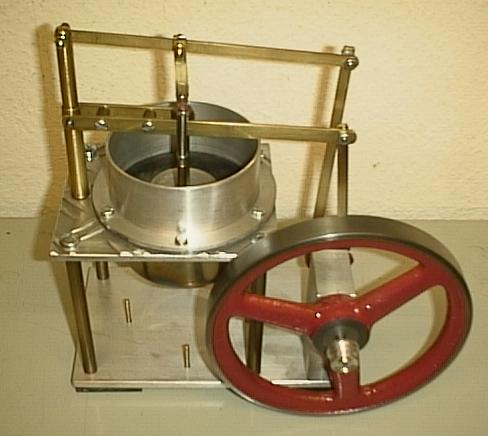exchemist
Valued Senior Member
"The cycle completes by atmospheric pressure" means the atmosphere does work on the gas to recompress it. This heats the gas and that heat is wasted. So in the power stroke some of the work done is in effect "lent" to the surroundings and comes back as waste heat in the second part of the cycle. There is no getting away from that: PV work is either done by or done on a gas, depending on whether it is expanding or contracting. See description here: https://chem.libretexts.org/Bookshe...rmodynamics/Thermodynamic_Cycles/Carnot_CycleThe point is, the "Law" only applies to cycles, though it is recognized that heat can indeed be converted into work 100% in a "process", such as expanding gas in a cylinder to drive a piston.
The further out the piston is driven the more the pressure drops, as you point out: "until the gas pressure asymptotically approaches zero."
A Stirling engine operates by heating and expanding a gas which raises the internal pressure relative to the external (atmospheric) pressure. The engine ( in the real world) is not operating in a vacuum.
So what happens when the gas does work drives out the piston to let's say double the volume.
Before adding heat to the working fluid the internal and external pressure were in equilibrium. As the gas expands and the heat is converted to work (100%) the internal pressure falls.
According to the ideal gas law, at double the volume, the pressure will be halved (in an isothermal process) so we end up with 0.5 atmosphere internal pressure as the engines piston approaches "bottom dead center" or the full extent of it's expansion stroke.
But at about 3/4 into the expansion, in a Stirling engine the heat input is cut off so the final portion of the stroke is completed without heat input. Momentum carries the piston the final distance. What happens to the pressure and temperature as the gas continues to expand and do additional work adiabatically?
The pressure already dropped down to 0.5 atmospheres.
Additional expansion and adiabatic cooling aside, what volume do we have to return the gas to in order to restore the internal pressure so that it is balanced by the external pressure of 1 atmosphere?
According to the ideal gas law, the volume would need to be reduced to 1/2.
At some point during expansion the external atmospheric pressure is going to overwhelm the falling internal pressure, and with the heat input having been cut off what will happen when the piston reaches bottom dead center?
Atmospheric pressure will drive the piston back, will it not?
In an internal combustion engine we need a flywheel to carry the engine through the compression stroke, but in a Stirling engine this is not necessary. The piston returns by atmospheric pressure.
So, if all the heat has already been utilized during the expansion stroke with 100% efficiency, and the cycle completes by external atmospheric pressure, returning the system to equilibrium or its starting condition, then how is it possible for the "Carnot Limit" to be valid which says the conversion efficiency is limited to say 25 maybe 30% or whatever.
The heat was already fully utilized 100% during the expansion stroke and from there the cycle is competed by atmospheric pressure.
How do we retroactively deduct 75% of the heat input reserved for the "cold reservoir" when it is already gone?
You still owe me a reply on how you are measuring the heat input and the work output, in order to work out the efficiency.


